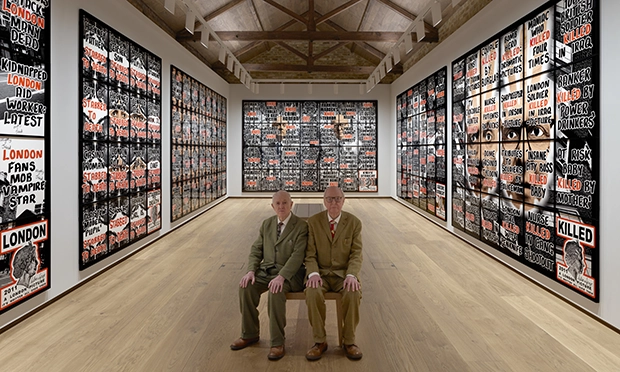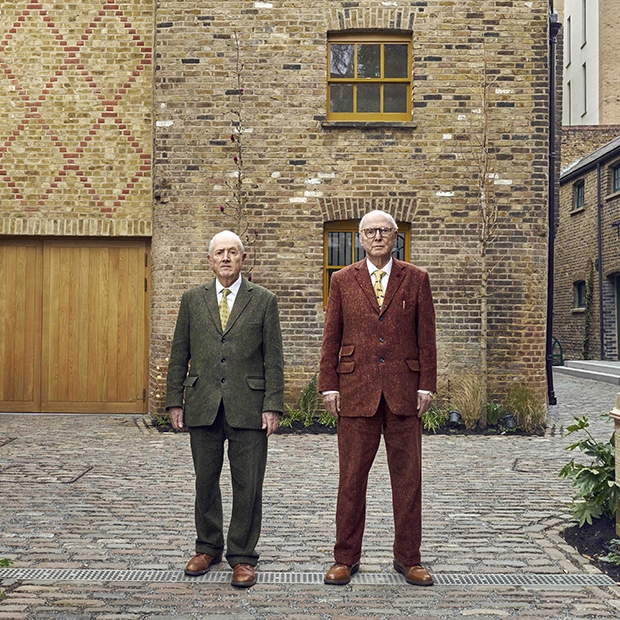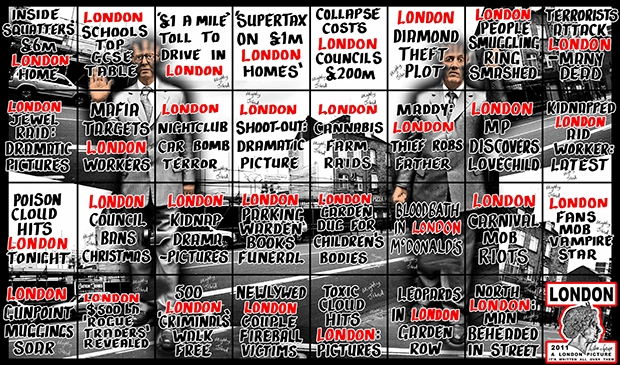Artists Gilbert & George on life in East London, sensationalism, and the success of their gallery

Gilbert Proesch and George Passmore inside their centre. Photograph: Prudence Cuming
With a new exhibition of LONDON PICTURES opening at The Gilbert & George Centre in Spitalfields, I dropped by for a chat with the artistic duo behind the project.
On my way to their gallery space off Brick Lane, I passed joyous families celebrating Eid, intermingled with tourists tracking down vintage clothes – quintessential East London.
Gilbert Proesch and George Passmore have lived and worked here since the 1960s, but it was only last April that they finally launched their own dedicated exhibition space.
I asked them about their relationship with the area and how the Centre had changed that.
SB: “You’ve been here for quite a while in East London; I wonder if you could say how East London has changed you, and how have you have changed East London?”
G&G: “I’m not sure we’ve changed the area, but the world was a very different place when we left college in 1971, entirely different.
“We played a small part in that change, that’s what artists are for. It was a strange feeling around here that we were able to make pictures.
“I think in Hampstead Heath it would be different.”

Gilbert & George’s PUPILS. Image: © Gilbert & George / courtesy The Gilbert & George Centre
SB: “Now you’ve opened this lovely Centre; you have often expressed a view that you feel yourselves to be outsiders. Does having a centre like this make you feel more like you’re insiders now, in the art world?”
G&G: “I think we’re a little bit insiders and a little bit outsiders, both. It depends who you’re talking to.
“We wanted to be different, we wanted to be outsiders, we wanted to do our own art work even when sometimes we have big shows somewhere else as well.
“We do both, but we like to be loners in some way in the East End of London and to create our art.
“We don’t have a lot of friendship with artists.”
SB: “And has the Centre done what you wanted it to do?”
G&G: “Yes, it’s been very successful. People [come] from different parts of the world, it’s extraordinary.
“A lot of Japanese young people, Latin American, European. Showing is very rare, so that’s why we created our own space.
“Wandering the streets of the world, we’re always stopped by young people saying ‘I love your art’, and when we say ‘what art?’, they’ve never actually seen an exhibition, just a magazine or a television programme.
“So we thought ‘let’s have a place where they can see it’.”

Gilbert & George in the courtyard of The Gilbert & George Centre. Photograph: © Tom Oldham / courtesy The Gilbert & George Centre
Gilbert and George’s new show displays work from a long-standing series based on newspaper posters.
Purloined from local newsagents, the images boast themes such as ‘sex attacker’, ‘murder’ and ‘riots’; their press release describes these as ‘a moral portrait of our times’.
Given that the Citizen runs more measured headlines, I was keen to know how they felt about the material they had opted to use in their work.
SB: “In what sense are the LONDON PICTURES a ‘moral portrait of our time’? I wonder if attention-grabbing headlines really do the reflect moral values of newspaper readers?”
G&G: “They are called the LONDON PICTURES, [but] they could be called ‘city pictures’ or ‘world pictures’.
“Wherever you go in the world, somebody’s just been mugged. It’s just not a local issue, it’s an international thing. Terror. Terror. It’s all over the world at the moment.
“There isn’t an airport in the world where you’re not searched [by security] for terrorists.”

LONDON by Gilbert & George. Image: © Gilbert & George / courtesy The Gilbert & George Centre
SB: “But are you doing justice to the East End to sensationalise it in this way?”
G&G: “Mostly, if you look, they’re very simple statements of fact. ‘Birthday party couple shot dead’. It’s a simple fact. We didn’t invent that.
“‘Schoolboy’s killer jailed for life’. It doesn’t say ‘shocking’ or… it’s a simple fact.
“This [is a] kind of cityscape, what’s going on in the city, we are not inventing it.”
And finally, the pair are well-known for their espousal of Brexit, so I was interested to find out whether leaving the European Union has achieved what they hoped it would.
SB: “I wonder how you feel about the way Brexit has affected modern life. Are you still happy with the outcome we’ve had from that process?”
G&G: “We don’t think about it. We think everything was fine with Brexit and fine afterwards.
“I didn’t see any great difference with it. Didn’t feel anything. All is fine.”
One wonders whether Gilbert and George shouldn’t be reading different newspapers.
